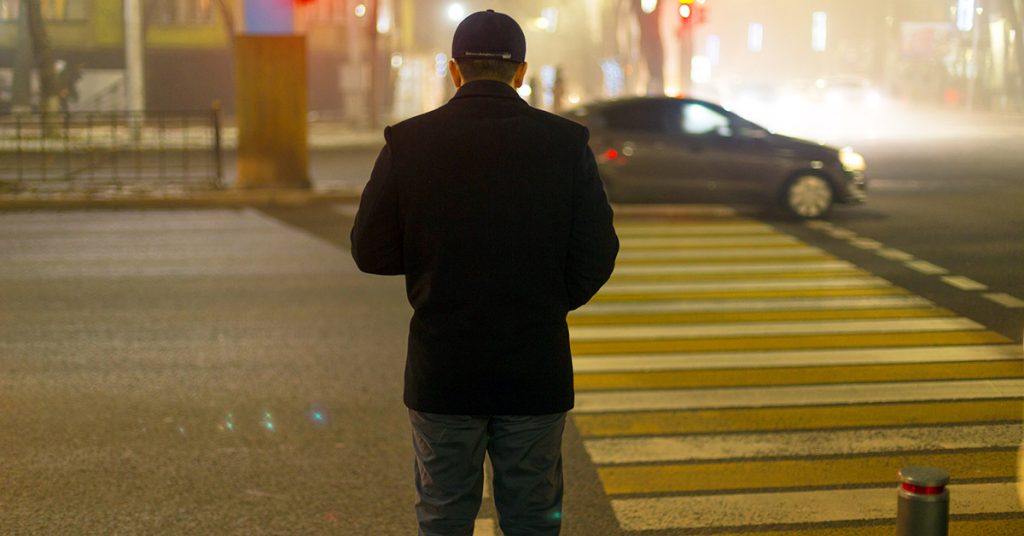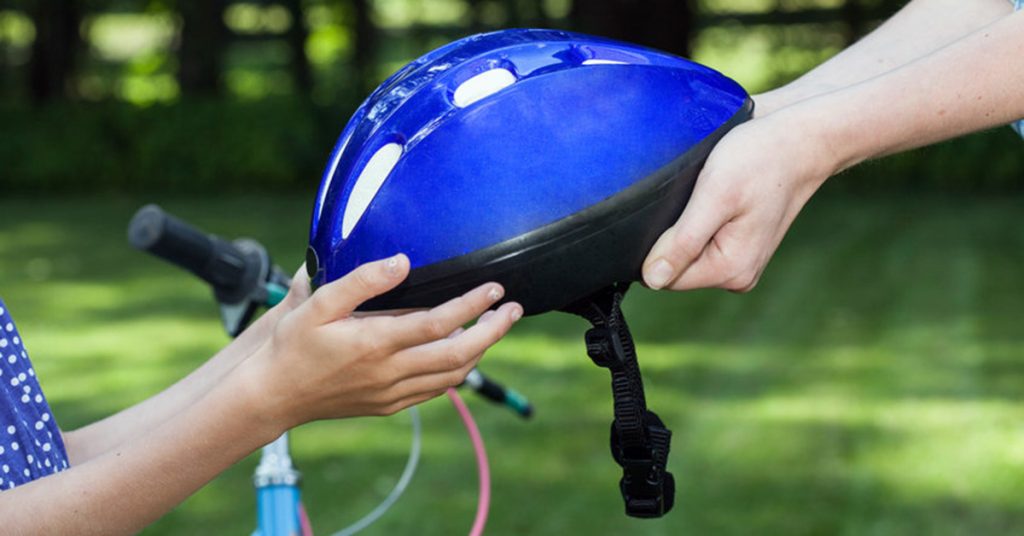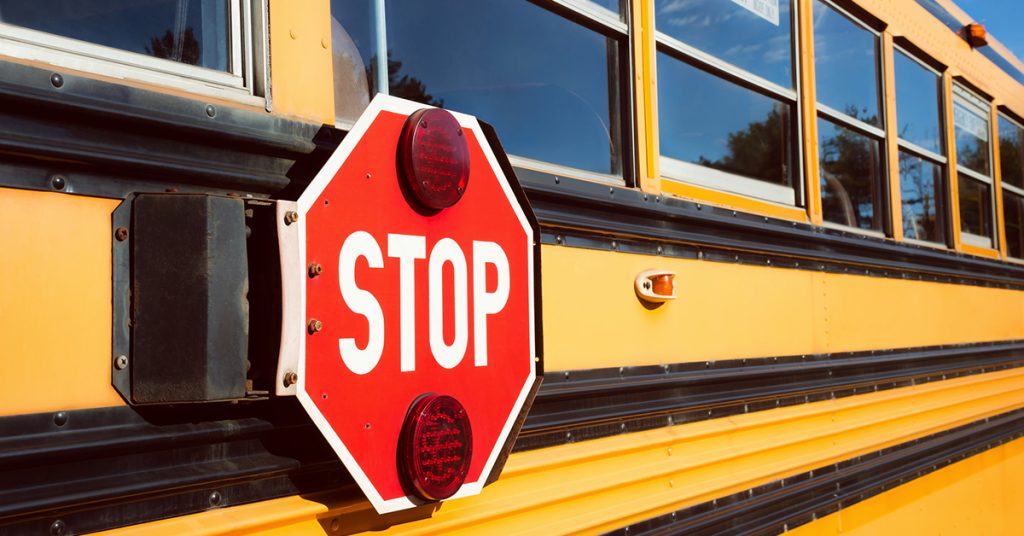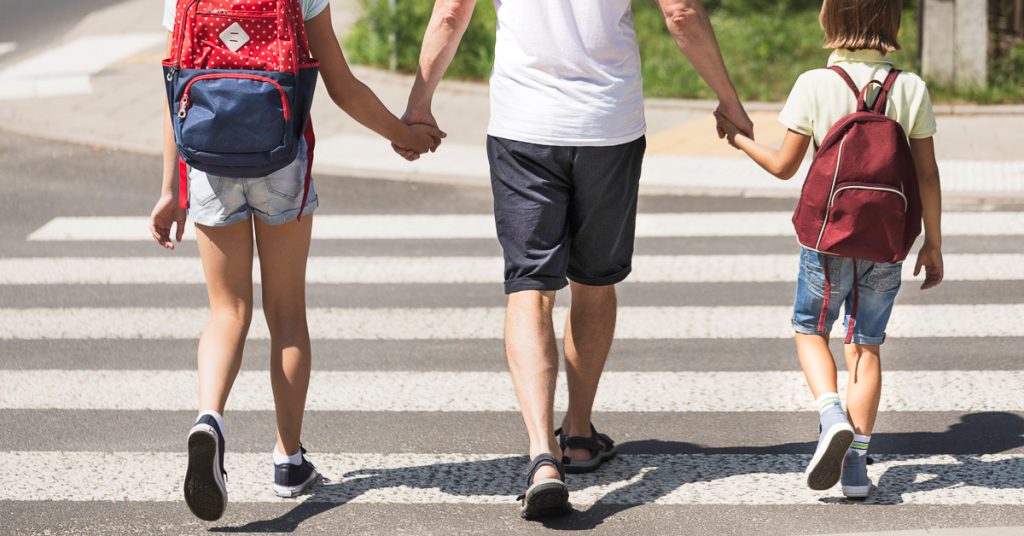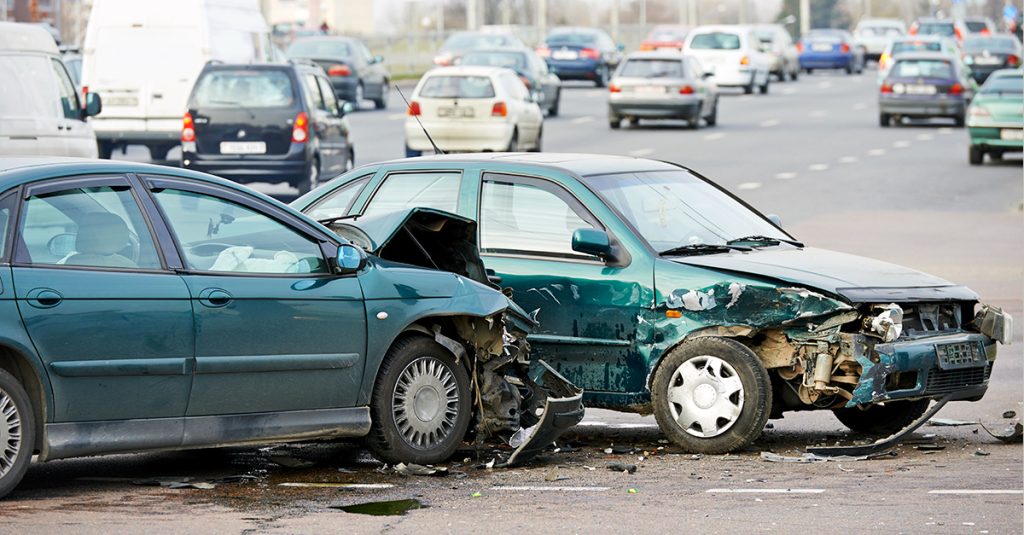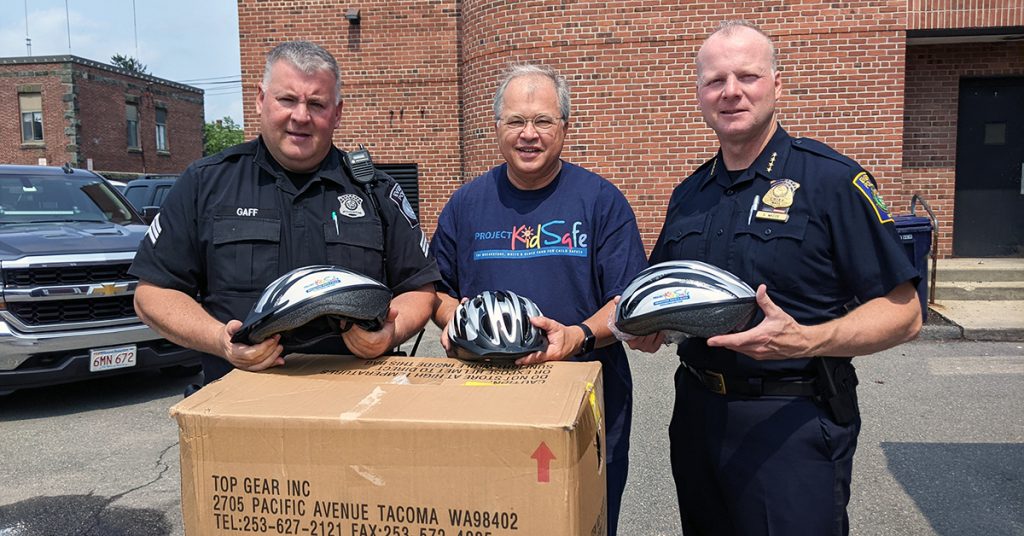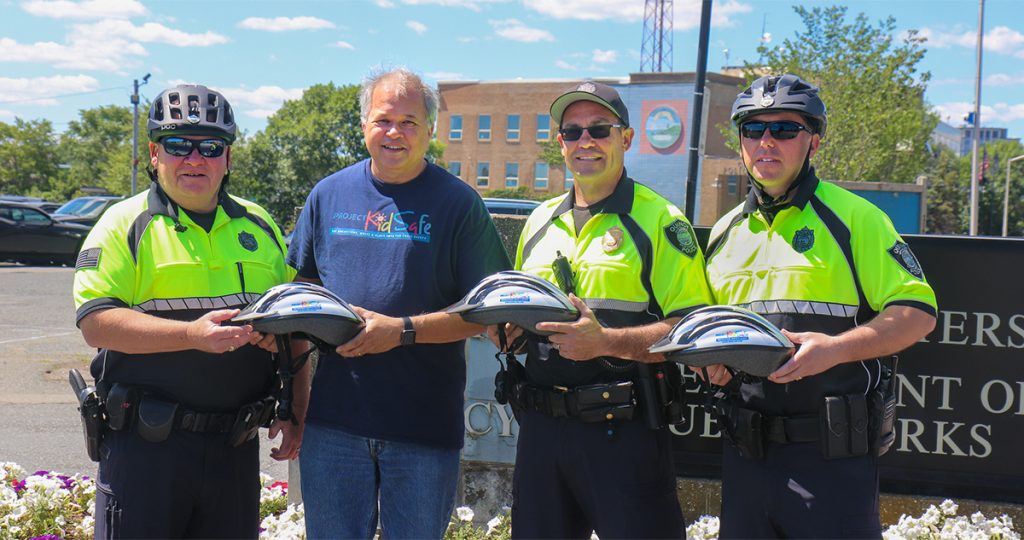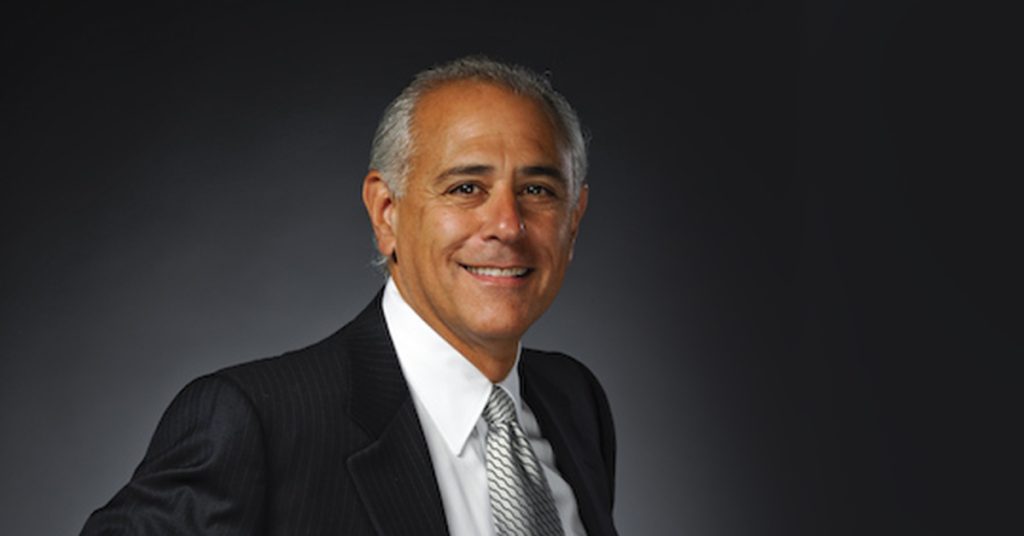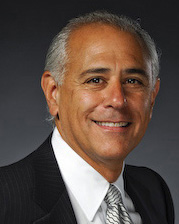Posts by Breakstone, White & Gluck
As the Days Get Shorter, Make Pedestrian Safety a Priority in Massachusetts
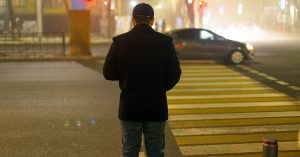
As the days get shorter, drivers must watch for pedestrians. The number of pedestrian fatalities has risen in Massachusetts during 2021.
The majority of all pedestrian fatalities occur at night or in dark light conditions, according to the National Highway Traffic Safety Administration (NHTSA). This is a significant point come October in Massachusetts, when the days get shorter and the walk home becomes darker.
As a driver, renew your commitment to travel safely near pedestrians this Fall. This is critical. In addition to shorter days, Massachusetts is seeing a rise in pedestrian fatalities as traffic volumes start to rebound. In August, the Massachusetts Department of Transportation (MassDOT) reported traffic volumes had returned to just 5 percent below pre-pandemic levels in 2019.
As of October 21, 2021, 58 pedestrians have died on Massachusetts roads this year, according to MassDOT crash data. 55 pedestrian fatalities were recorded in 2020, when traffic was lightest due to Covid 19 stay at home policies. Prior to the pandemic, there were 78 fatal pedestrian injuries statewide in 2019.
There have been 1,086 total pedestrian accidents reported in 2021 so far, including those involving fatal injuries, non-fatal injuries and property damage without injury, compared to 1,443 pedestrian crashes in 2020 and 2,198 pre-pandemic in 2019. (Source: MassDOT, 2017-2021 Pedestrian, Cyclist and Motorcyclist Crashes by Injury).
While helpful, the data is just a snapshot. A better resource: ask anyone who walks if driving patterns are still irregular due to the pandemic. Roads may be less congested, but drivers are picking up speeds at times. This endangers pedestrians, especially at night, when there is less visibility.
Reminders for Driving Safely Near Pedestrians and Reducing the Risk of Injury
Drive Slowly and Watch for Pedestrians
Drive slowly and always look for pedestrians. Take an extra moment to look in all directions before you step on the gas. Pedestrians are more likely to blend in at night, even in well-lit areas.
Yield and Stop at Crosswalks
Drivers have a responsibility to yield to pedestrians before turning at traffic signals and to stop or yield for pedestrians to safely walk through crosswalks. Many pedestrian accidents at night occur in intersections and crosswalks.
Once you start moving, you can attempt to break quickly but you really have less control, especially in short distance situations, such as when turning at an intersection or backing out of a parking space. Take a moment and take a good look for pedestrians first.
Give Yourself More Time When Getting in Your Car
Drivers can reduce their risk of hitting a pedestrian by giving their full attention to the road. To do this, give yourself time to get ready for the ride while you are parked: buckle your child up and set up your cell phone in hands-free mode if you plan to use it. Make sure you have directions typed into your GPS or you know where you are going.
When you are finished, then give yourself time to turn on the vehicle and look for pedestrians.
Drive at Night Without Distractions
The state of Massachusetts now allows drivers to use cell phones in hands-free mode, but this can be a dangerous distraction when driving at night. The best policy is to pull over in a legal parking space if you need to call someone and avoid causing a car accident or truck crash, resulting in pedestrian injuries.
Reduce Your Speed
During the day and at night, you give yourself more time to stop for pedestrians when you travel at the speed limit or below if necessary for safety conditions.
Look for Both Pedestrians and Cyclists
Pedestrians may or may not wear bright clothing, so you have to really check when you drive at night or in the early morning. Pedestrians may be hard to see, even when traveling through a well-lit intersection or parking lot.
Cyclists may be easier to see as they approach. In Massachusetts, cyclists must use a white headlight and red taillight or rear reflector at night, or specifically from ½ hour after sunset until ½ hour before sunrise under M.G.L. c. 85, § 11B.
This means you may see a white light when a cyclist is approaching and red light (or reflector) from behind. You may also see reflective material on a cyclist’s pedals.
Consider the Impact of Darkness on Drivers
It is simply harder to see at night. Not just for senior citizens. Age-related vision changes can pay a toll much earlier than retirement age. For instance, a 50-year-old driver may need twice as much light to see as well as a 30-year-old, according to the National Safety Council. It is critical for all drivers to schedule an annual eye exam, get proper rest and set aside distractions.
Older Drivers
Still, older drivers may struggle the most when driving at night. At 60 or older, drivers may not see as well at night and may suffer from a loss in color and depth perception, making it harder to judge speeds and distances, according to the American Optometric Association.
Safety precautions for older drivers traveling at night:
- Have an annual eye examination.
- Consider taking a driving class to brush up on your driving skills and learn about age-related vision changes. The AARP offers courses and other organizations may also.
- Limit or avoid driving at night.
- Reduce your speed and expect pedestrians.
- Be cautious at intersections, taking extra care to yield to pedestrians.
Limit Teen Driving at Night
As a parent, let your teen drive during the day, but consider limiting their driving hours at night this Fall. Teens are still learning and driving safely at night takes practice. And right now, traffic is even less predictable and your teens may be driving alongside more trucks and delivery vans as we approach the holidays.
This is a suggestion. But remember under the Massachusetts Junior Operator Law, teens are not permitted to drive at all between 12 a.m. and 5 a.m.
Free Legal Consultation – Boston Pedestrian Accident Attorneys
Breakstone, White & Gluck is a top-rated Boston personal injury law firm. With more than 100 years combined experience, our attorneys provide thorough and aggressive representation to those injured by negligence across Massachusetts, including in Boston, Cambridge, Winthrop, Arlington, Somerville, Everett and Chelsea. We also serve clients across the state, including in Quincy and the South Shore, Hyannis, Barnstable and Cape Cod, Framingham, Worcester and the Danvers and the North Shore.
Our firm specializes in representing pedestrians and cyclists who have been injured in auto accidents, truck accidents and bus crashes, including MBTA bus accidents in the city of Boston.
For a free legal consultation, contact our firm at 800-379-1244 or 617-723-7676 or use our contact form.
The Boppy Company Recalls 3.3 Million Newborn Loungers Linked to Deaths
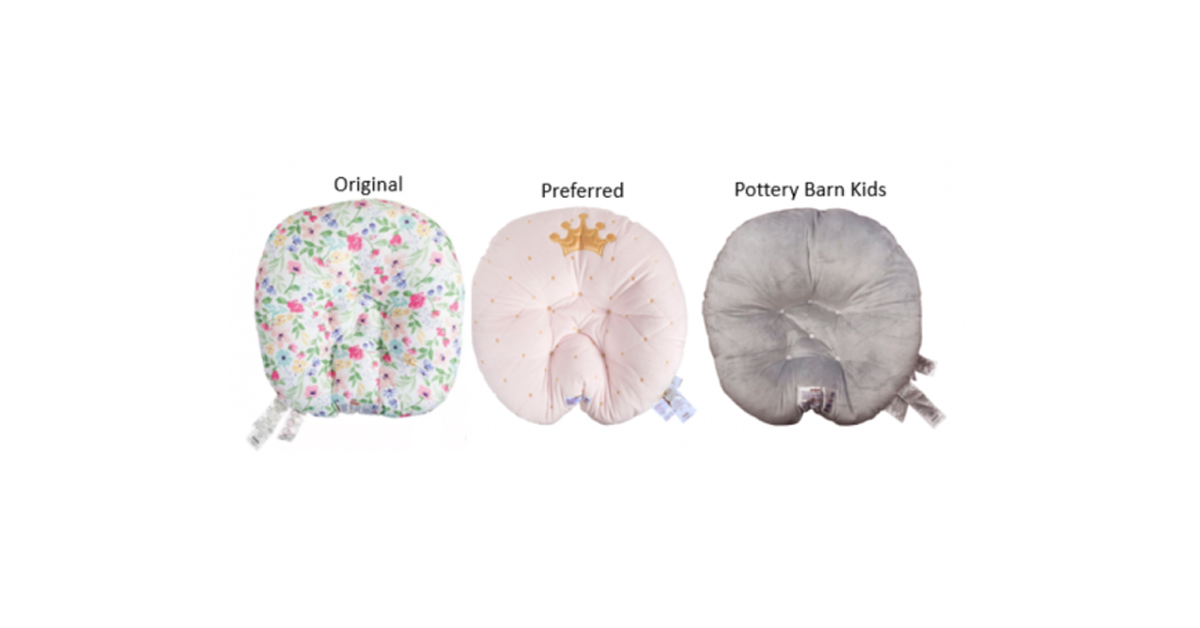 The Boppy Company has now recalled 3.3 million newborn loungers after the deaths of 8 infants. The U.S. Consumer Product Safety Commission (CPSC) and The Boppy Company announced the recall on September 23, 2021. Parents are urged to immediately stop using these products and to remove them from their homes.
The Boppy Company has now recalled 3.3 million newborn loungers after the deaths of 8 infants. The U.S. Consumer Product Safety Commission (CPSC) and The Boppy Company announced the recall on September 23, 2021. Parents are urged to immediately stop using these products and to remove them from their homes.
The infants reportedly suffocated after being placed on their back, side or stomach in these loungers. The deaths were reported between December 2015 and June 2020.
The recalled products include:
- Boppy Original Newborn Loungers
- Boppy Preferred Newborn Loungers
- Pottery Barn Kids Boppy Newborn Loungers
Prior to the recall, The Boppy Company sold the loungers from January 2004 through September 2021 for $30-$44. A total of 3.3 million loungers were sold in the U.S., including by Amazon, Walmart, Target and Pottery Barn Kids. Another 35,000 infant loungers were sold in Canada. The newborn loungers were sold in a number of colors and measured about 23 inches long, 22 inches wide and 7 inches high. Consumers can contact the company for a refund.
In the CPSC’s announcement, The Boppy Company said the infant lounger was not marketed as an infant sleep product and included warnings against unsupervised use. But the CPCS noted the loungers and pillow-like products are not safe near infants, who sleep so much and can quickly suffocate if they roll or turnover.
The CPSC emphasized babies should sleep on their backs, on a firm and flat surface in a crib, free from any blankets, pillows or padded crib bumpers.
The CPSC has been actively investigating the hazards of infant sleep products. On April 5, 2019, the CPSC and Fisher-Price issued a shocking consumer warning, stating that 10 infants, all 3 months or older, had died rolling over in the Fisher-Price Rock ‘n Play sleepers. Parents were initially urged to stop using the products when children turned 3 months or started to turn.
A week later, more than 30 reports of infant fatalities had emerged. On April 12, 2019, after nearly 10 years of sales, Fisher-Price issued a full recall of 4.7 million Rock n’ Play sleepers and warned parents to stop using the product.
The Washington Post later reported Fisher-Price had developed the Rock ‘n Play product after consulting one physician and had not conducted any clinical research. The newspaper would also report the number of infant deaths had risen to 90.
Infant Sleep Product Recalls and Deaths After the Fisher-Price Rock ‘n Play
After the Fisher-Price Rock ‘n Play recall, the CPSC announced several other infant sleeper recalls for products made by Kids II, Summer Infant, Graco and other companies. In June 2021, the CPSC announced another Fisher-Price recall for the 4-in-1 Rock ‘n Glide Soother, and warned that four infants had died while using the product between April 2019 and February 2020. This product went on the market in 2014 and 120,000 units were sold in the U.S.
At the same time, the CPSC announced the recall of 55,000 Fisher-Price 2-in-1- Soothe ‘n Play Gliders between November 2018 and May 2021. No fatalities were reported in association, but the CPSC warned consumers that, “Inclined products, such as gliders, soothers, rockers and swings are not safe for infant sleep, due to the risk of suffocation.”
In 2019, the CPSC released initial findings on infant sleep product research.
New Safety Standard For Infant Sleep Products
In June 2021, the CPSC approved a new federal standard for infant sleep products. Beginning next year, products intended or marketed for infant sleep must meet this new mandatory standard. Under the new standard, if an infant sleep product does not meet a current CPSC sleep standard, it must be tested to ensure the sleep surface angle is 10 degrees or less. The Fisher-Price Rock n’ Play had a 30-degree incline. Moving forward, infant sleep products must also comply with the CPSC’s safety standard for bassinets and cradles.
As the CPSC implements the new safety standard, the agency is also offering parents tips for putting infants to sleep safely. This starts with setting up your child’s sleep and play areas for safety.
Free Legal Consultation – Boston Product Liability Lawyers
The Boston product liability lawyers at Breakstone, White & Gluck have more than 100 years combined experience representing those injured or killed by defective products. If you or a loved one have been injured by a company’s negligence, learn your legal rights. Contact our law firm at 800-379-1244 or 617-723-7676 or use our contact form.
Helping Children Remember Bicycle Helmets During Back to School
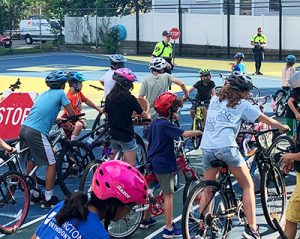
On your mark, get set, go! Breakstone, White & Gluck was pleased to donate bicycle helmets for children at the Arlington Police Department’s Bicycle Safety Day.
For many children, back to school means back to the school bus. But more and more, many students are walking or biking to school.
Back to school is a good time to introduce children to bicycle safety and this year, Breakstone, White & Gluck was pleased to partner with the Waltham and Arlington police departments to give helmets to children.
On Saturday, August 28th, the Waltham Police Department gave away free Project KidSafe helmets to children at the “Meet the New Chief Day.” The Arlington Police Department also gave away free helmets at Bicycle Safety Day on August 24th at Gibbs Junior High School, where many students walk or bike each day to class.
Our Tips to Help Children Wear Bicycle Helmets Back to School This Fall in Massachusetts
A new school year means a new routine. Whether you or your child ride daily or on occasion, we urge you to commit to wearing a helmet.
According to the National Highway Traffic Safety Administration, wearing a properly fitted helmet is the “single most effective way” to reduce head injuries and fatalities resulting from bicycle crashes. The Insurance Institute for Highway Safety reports the majority of cyclists who ultimately die after a bike crash first sustained a head injury as their most significant injury.
Children Must Wear Bicycle Helmets Under Massachusetts Law. Under Massachusetts law, cyclists who are 16 and younger are required to wear helmets when riding a bicycle. Helmets should be properly fitted and meet the safety standards set by the Consumer Product Safety Commission.
Beyond safety, there are other consequences. A police officer can actually impound your child’s bike for up to 15 days if they are caught riding without a helmet in Massachusetts, though many officers work hard to avoid this step and would rather encourage helmet use.
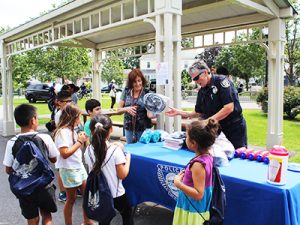
Waltham police officers give away free bicycle helmets at the “Meet the New Chief” event in August.
Why Parents and Adult Cyclists Should Wear Helmets. Cyclists of all ages should wear helmets to protect themselves.
As a parent, if you wear a helmet and make sure your child wears one when you ride together, your child will take notice. They are more likely to wear a helmet even when you are not there and they will have some practice at fastening their own helmet.
Label Your Child’s Helmet. Write your child’s name inside the helmet, on the strap or on the outside of the helmet.
Wear Your Helmet; Do Not Carry It In Your Backpack. Many children (and adults) ride, then put their helmets in their backpack while they are at work or school. Encourage your child to keep their helmet outside their backpack so they put it right on.
Buy a Durable Bike Lock. Purchase a durable bike lock in case your child cannot find their helmet and has to walk or get a ride home from school or a friend’s house. Keep this on their bike at all times. Insist that your child should contact you and never ride without a helmet.
Buy Your Child a Spare Bike Helmet. Purchase your child an extra bicycle helmet now before they misplace theirs. Unless you live near a bike shop, it can be difficult to step away from your routine to go purchase a bike helmet right away, especially during the busy Fall season.
At the same time, purchase a spare helmet for yourself, too. Keep your spare at home or at the office. This will come in handy if you damage your helmet, lose it or decide you want to take the Blue Bikes bikeshare home.
Free Legal Consultation – Boston Personal Injury Attorneys
With more than 100 years combined experience, Breakstone, White & Gluck has been consistently recognized as a top-rated Boston personal injury law firm. Our attorneys specialize in representing those injured by negligent driving, bicycle accidents, premises liability accidents, defective and unsafe products, construction accidents, medical malpractice and wrongful death.
If you have been injured, learn your rights. For a free legal consultation, contact Breakstone, White & Gluck at 800-379-1244 or 617-723-7676 or use our contact form.
Back to School Bus Safety in Massachusetts

School buses are back on the road in the Boston area. Take time to plan for safety.
As students head back to school, safety is paramount near school buses. Breakstone, White & Gluck offers reminders to help parents and drivers make safe decisions.
Parents: Learn Massachusetts School Bus Safety Laws
School transportation offices offer a wealth of information, including on safety procedures, safety laws and bus routes. Read the materials your school transportation office sends you promptly. Save the office phone number in your cell phone contacts.
You can also learn by asking your child what they learn. In Massachusetts, students are required to receive classroom instruction on safe riding practices at least three times each school year, under M.G.L. c. 90, § 7B. School districts are also required to conduct twice a year on-bus emergency evacuation drills. You can learn more from the School Health Services website.
The Risk for School Bus Accidents and Injuries
The National Safety Council reports school buses are the safest way for children to get to school. But still, school bus accidents are reported each year.
In 2019, there were 109 fatalities and 13,000 injuries in school bus-related accidents across the U.S., according to the National Safety Council data tabulations. School bus passengers suffered about 6 percent of deaths and 34 percent of injuries in school bus-related accidents between 2010 and 2019. Drivers and passengers in other vehicles suffered nearly 70 percent of the deaths and 53 percent of the injuries. Pedestrians accounted for 17 percent of all deaths.
One important insight: Two-thirds of all children killed in school bus-related fatalities are outside the vehicle at the time, according to the National Safety Council. This means the steps we all take to help students get on and off the school bus safely are critical.
School districts and bus companies have a responsibility to hire school bus drivers who are licensed, trained and have safe driving records. In addition, they have a duty to maintain the mechanical operations and keep a work log. Meanwhile, other drivers on the road have a responsibility to use caution and follow safety laws near school buses. Drivers who take this responsibility seriously can make the drive easier and safer for school children, bus drivers and others on the road.
- As a parent, learn as much as you can about school bus safety procedures from your school.
- Ask about training requirements, criminal and sexual offender registry checks and physical exams drivers must undergo.
- Support and reinforce what your child learns at school and from the bus driver.
- Take a ride on the school bus with your child if you have the chance.
- Notice your child’s bus driver must wear a seat belt. Your child’s school district may or may not have installed seat belts for children. They are not required by state law. School districts can install them following federal safety standards.
- Seat belts are, however, required in other school transportation vehicles, including vans and vehicles carrying 8 or fewer passengers.
- Join your child at the school bus stop. Help them learn how to get on and off the school bus safely.
- Read permission slips and ask questions before you allow your child to ride the bus for sporting events and field trips. Ask if the school district will provide the bus and bus driver, or if a private company has been contracted. Ask for emergency contact numbers and procedures specific to the trip, should the bus be delayed or if there is a safety issue.
Teaching Children How to Get On and Off a School Bus Safely
Getting On a School Bus Safely
For a young child, the sight of a school bus can be exciting and over stimulating.Walk your child through the steps of safety. Teach them to recognize the difference between yellow and red.
Explain that the school bus will approach and flash its yellow lights as it slows down, but that your child should not move toward the bus yet. This is a good time for your child to pick up their backpack and stand at least 10 feet back from the road.
Your child should wait for the school bus to reach a full stop, flash its red lights and extend the stop sign. The bus driver will open the door, make eye contact with your child and let them know they can board the bus.
Exit a School Bus Safely
When stepping off the bus, your child should cross the street in front of the school bus, never behind. Your child should step off the road and onto the sidewalk right away. Let your child know if they leave any belongings on the school bus, you can call the school transportation office later.It is not safe to turn back because school bus drivers and other drivers are not expecting this. While school bus drivers are supposed to check mirrors before moving ahead with their route, there is a very real risk they will not see your child. The greater risk is other drivers may become impatient and start to move toward your child before the bus has stopped flashing its safety lights.
Other Drivers Should Keep a Safe Distance From School Buses
Other drivers have a responsibility to travel safely near school buses and follow traffic laws. This starts with traveling at slower speeds and being prepared to stop.
In Massachusetts, “no person shall operate a motor vehicle within a distance of 100 feet behind a school bus,” per M.G.L. c. 90, § 14. Drivers must also reach a full stop for school buses that have stopped and activated signals to let children on or off. Drivers must remain stopped until the school bus pulls back its stop sign and starts moving again.
Never pass a school bus that has stopped and is flashing its lights. You can cause a very serious accident involving a school bus or another vehicle. Drivers who violate this law can expect a $250 fine for the first offense if they are caught by police or if the school bus driver reports their license plate, M.G.L. c. 90, § 14. Repeat offenders can face additional fines up to $2,000 and license suspensions – all for making a reckless decision stemming from impatience. This is a decision you will only regret later, especially if you cause someone injury and face a civil lawsuit seeking financial damages.
These are simple laws. But many drivers follow school buses more closely than they realize. Next time, try leaving a little more room. You will give the school bus driver more time and open up your own view of the road, helping you to make safer decisions and avoid a collision with the bus or a car accident.
Just as important is safety near school bus stops. Slow down near school bus stops. Never back up your car out of your driveway near a school bus stop. Park your car in a position that allows you to drive out safely in the morning or wait until the bus has come and gone.
While parents and children should stay 10 feet back from the road, there are times when children or pets may step into the road. You have to be prepared to stop – and be patient to avoid an accident.
Distracted Driving Near School Buses
Picking up a cell phone can be a deadly decision near a school bus, where young children and other pedestrians and cyclists may approach your vehicle closely at times. Commit to safety and focus on the roads, not your device, as students head back to school.
The Dangers of School Buses at Intersections
School buses can obstruct a driver’s view at an intersection. Stay back 100 feet or more so you can watch for the school bus as well as pedestrians and cyclists, and avoid a traffic accident.
Remember that pedestrians may approach near sidewalks and crosswalks, but cyclists may travel in the traffic lane or to the right of traffic. If a school bus has stopped in front of you at an intersection, you may not be able to see if a cyclist has stopped next to them until traffic starts to move.
Free Legal Consultation – Boston Personal Injury Lawyers
Breakstone, White & Gluck has more than 100 years combined experience representing those injured by negligence or wrongdoing in Massachusetts. If you have been injured by someone else’s negligence, learn your legal rights. For a free legal consultation, contact the Boston personal injury lawyers of Breakstone, White & Gluck at 800-379-1244 or 617-723-7676 or use our contact form.
Back-to-School Safety Reminders for Massachusetts Drivers
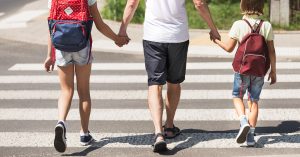
As students head back to school in Massachusetts, drivers are urged to travel safely and follow speed limits.
Back-to-school is a fun and exciting time for students, especially getting to reconnect with friends after summer vacation. As students get ready, drivers should too. You should expect to see more students walking, biking or waiting at school bus stops. Commit to drive safely and be mindful of speed limits.
Take a Test Drive
Before students return, drive through your community, school parking lots and nearby intersections. Observe whether there has been roadwork or if new bike lanes have been added. Look for new traffic signs related to parking, school drop-offs and traffic direction. Look for sidewalks. As a driver, you have to make quick decisions and this check will help you later.
Look Right, Left, Front, Back
Drivers can prevent many traffic accidents by checking their blindspots and all sides of their vehicles at intersections more. At red lights and stop signs, it is critical that you check, especially from behind. You must watch for pedestrians, but also cyclists. Consider that after you initially stop your car, a cyclist could approach from behind. If you neglect to check, you may not see them before the encounter turns into a very serious bicycle accident.
When you park, commit to look. Check all sides, including your blindspot. Use your back-up cameras and really look for pedestrians, whether you are in a school parking lot or at a local restaurant or other business. Before you step out of your vehicle, check again so you do not hit a cyclist or pedestrian with your door. These accidents can happy very suddenly if you do neglect to look and a cyclist is nearby. Learn more about dooring accidents.
Slow Down for Students
In Massachusetts, drivers must follow a 20 mph speed limit in school zones. The Vision Zero campaign has documented that slower is safer for pedestrians, even just 5 mph.
From the City of Boston’s Vision Zero campaign:
- There is a 17 percent likelihood of fatality or severe injury when drivers travel 20 mph and hit a pedestrian.
- At 25 mph, the risk of pedestrian death or severe injury rises to 30 percent.
- At 30 mph – still not that fast – there was a 47 percent chance of a pedestrian accident turning fatal.
Travel Safely Behind School Buses
After the past year, it is more important than ever to practice patience near school buses and school bus stops. Each day may be different as parents, children and school bus drivers try to manage under COVID-19 conditions. Remember the basics of school bus safety.
When a bus flashes its yellow signals, this means the driver is getting ready to stop. Other drivers on the road should slow down and prepare to stop. Drivers must stop when the school bus activates its red lights and extends its stop sign.
Never pass a school bus that has activated its signals and extended its stop sign. In Massachusetts, drivers must keep vehicles at least 100 feet behind a school bus at all times. M.G.L. c. 90, § 14
When a school bus stops, drivers traveling in both directions must stop. And if you end up stopping behind a school bus that is letting off children, just wait. Wait until all the children have fully stepped onto the sidewalk and give the bus distance when it starts moving again. This also gives you time to assess the traffic and look for an opportunity to get off the bus route if you want to.
Stop and Look for Pedestrians at Crosswalks and Intersections
Drivers should commit to stop for students in crosswalks. Students expect drivers to stop and if drivers travel slowly and are prepared to stop, they have extra time to make safe decisions near children.
In Massachusetts, drivers have a responsibility to yield, slow down or stop for all pedestrians in marked crosswalks. Drivers must stop for pedestrians at crosswalks with an activated “Walk” signal. Another point is that you should follow other drivers and their decisions near crosswalks. When the car in front of you stops for a pedestrian at a marked crosswalk, you have a duty to stop and wait for the pedestrian to cross.
Read more on Breakstone, White & Gluck’s page on pedestrian crosswalk laws.
Teens Suffer Many Pedestrian Injuries
When you hear “back-to-school safety,” many people think of young elementary school students. But in “Alarming Dangers in School Zones, 2016,” SafeKids Worldwide reports that older teens, ages 15-19, account for 26 percent of all children age 19 and younger. Yet the older teens accounted for about half of all pedestrian fatalities, with many occurring at night.
This is relevant because when school begins, there will be a rise in traffic and pedestrian activity even outside school hours. High school students may be participating in afterschool sports, extracurricular activities, an afterschool job or visiting more with friends.
Call 911 to Report Injuries to Children, Pedestrians and Cyclists
If you pass a student or an older pedestrian or cyclist who has been injured, stop and call 911. This is a really difficult time as the pandemic continues and there is likely to be traffic congestion at times and demands on our emergency response services.
Never assume a pedestrian has help. Nearly 20 percent of all pedestrian fatalities involve hit-and-run crashes, according to the AAA Foundation for Traffic Safety. If a driver flees the scene, the victim may not have anyone to call 911, delaying their access to medical care. Every minute counts to a pedestrian injured in a car accident.
About Breakstone, White & Gluck – Boston Pedestrian Accident Lawyers
With more than 100 years combined experience, Breakstone, White & Gluck fights for justice for clients who have been seriously injured by negligence or wrongdoing. Our lawyers are committed to excellence in every personal injury case we handle. We have earned consistent recognition in The Best Lawyers in America and Massachusetts Super Lawyers for our results for clients.
If you have been injured, learn your legal rights. For a free legal consultation, contact us at 800-379-1244 or use our contact form.
Driver Beware When Approaching These High Crash Intersections in Massachusetts
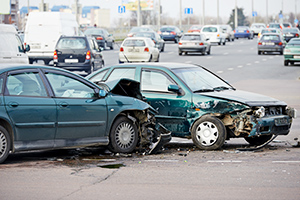
Read and find out if you travel through one of the top crash locations in Massachus
While drivers have a duty to operate with reasonable care and follow traffic laws, it is also worth noting the road you are traveling on. In Massachusetts, certain intersections have a track record of more car accidents than others.
Which intersections? In its most recent report, the Massachusetts Department of Transportation (MassDOT) shared the top 200 crash locations across the state. Released in September 2020, MassDOT’s 2017 Top Crash Locations Report offers insights as drivers plan their summer travel and resume commuting.
The rankings are based on reports to the Registry of Motor Vehicles’ Crash Data System from 2015-2017. A weighted methodology was used to compile the list.
Here are the top 10 car crash locations in Massachusetts:
- VFW Highway at Bridge Street, Lowell
- Randolph Avenue at Chickatwabut Road, Milton
- Morton Street at Harvard Street, Boston
- Ash Street and West Elm Street, Brockton
- Appleton Street at Central Street, Lowell
- Pleasant Street at Lincoln Street, Stoughton
- Main Street at Plainfield Street, Springfield
- High Street at Cabot Street, Holyoke
- Broadway at Third Street, Chelsea
- Saint James Avenue at Saint James Boulevard, Springfield
Several communities had multiple intersections on the list. Lowell has four of the top 25.
Top Crash Locations in Lowell
Two of the highest-ranked intersections were on the VFW Highway along the Merrimack River in Lowell. The VFW Highway at Bridge Street was named the top crash location statewide. The VFW Highway and Mammath Road ranked 22nd.
Also in Lowell, Appleton Street at Central Street and School Street at Branch Street appeared among the top 25 motor vehicle crash areas.
Brockton Top Crash Locations
MassDOT listed 31 Brockton intersections among the top 200 crash locations. The five top crash locations in Brockton:
4) Ash Street and West Elm Street, Brockton
15) Court Street at Montello Street, Brockton
23) Forest Avenue at Bouve Avenue, Brockton
24) Main Street at Nilsson Street, Brockton
25) Warren Avenue at Father Kenney Way, Brockton
One of the top crash locations was the area of North Quincy and Chestnut Streets on the Abington and Brockton border. Nearby, two Randolph intersections along Route 28 appeared on the list. At 41 was the intersection of South Main Street and Union Street. North Main Street and Scanlon Drive ranked 126 (this finished in the same position as six other intersections in Brockton, Lowell, Cambridge and two locations in Worcester).
Can You Change Your Commute to Avoid High Crash Locations?
Every driver wants to avoid a car crash. Apps such as Google Directions and Waze can offer valuable insights about traffic volumes. But we encourage you to look through the full MassDOT list of top crash locations.
If you travel through one of these intersections, consider why there are so many auto accidents. Some roads have high traffic volumes, especially during commuting hours. With more drivers, you may see more unsafe maneuvers, such as talking on a cell phone, speeding or failure to yield. Other roads have become large truck routes or are just aging, with outdated traffic infrastructure or poor lighting.
If you can, try to avoid these intersections or adjust your commute to avoid peak traffic. If you must travel these areas, pay attention and consider safety, near other vehicles as well as other pedestrians and cyclists. And watch for change. If you search online, you may find some of these intersections are scheduled for re-construction in the near future.
Free Legal Consultation – Contact Our Boston Car Accident Lawyers
Breakstone, White & Gluck offers our clients more than 100 years combined experience in handling car accidents, truck crashes and other motor vehicle collisions. Clients turn to us for our experience, expertise and our commitment to achieving the best result in every case. Read about our past results for clients in personal injury cases.
If you have been injured by another driver, learn your legal rights for seeking compensation. For a free legal consultation, contact our car accident attorneys at 800-379-1244 or 617-723-7676 or use our contact form.
Breakstone, White & Gluck Donates 100 Children’s Bicycle Helmets to the Everett Police Department
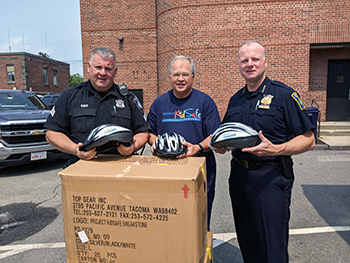
Attorney David W. White delivered 100 helmets from our Project KidSafe campaign to Everett Police Chief Steven A. Mazzie and Sgt. Joseph Gaff.
As summer continues, more children are riding bikes and Breakstone, White & Gluck is pleased to be donating bicycle helmets through our Project KidSafe campaign. This morning, Attorney David W. White delivered 100 bike helmets to Everett Police Chief Steven A. Mazzie and Sgt. Joseph Gaff.
This is the 6th year Breakstone, White & Gluck has made the donation through the Everett Police Department. Each year, our attorneys donate the helmets and the Everett Police Department decides how to distribute them to best reach children who need one. We are excited to see what this year holds!
Breakstone, White & Gluck and our Project KidSafe Campaign
Founded in 1992, Breakstone, White & Gluck represents those who have been injured by negligence across Massachusetts. Our attorneys are committed to encouraging children to wear helmets to protect against head injuries. Through our Project KidSafe campaign, we have now donated more than 33,000 helmets to children across Boston and Massachusetts.
Breakstone, White & Gluck Partners With Massachusetts Police Departments on Children’s Bike Safety
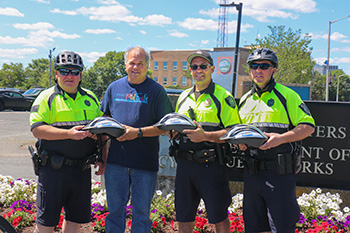
Left to Right: Quincy Police Officer Christopher Bulger, Attorney David W. White, Quincy Police Lt. Robert Bina and Quincy Police Officer William Mitchell.
Breakstone, White & Gluck is pleased to continue our partnerships for bike safety with local police departments in the Boston area.
As part of our Project KidSafe campaign, Breakstone, White & Gluck will donate children’s bicycle helmets to 10 local police departments during 2021.
In June, our attorneys were pleased to deliver helmets to the Quincy Police Department, Lynn Police Department, Norwood Police Department, Brockton Police Department and Randolph Police Department. We donate the helmets, but each department decides the best way to give the helmets away to children in their community who need one or who need a replacement helmet to ride safely. The police departments may organize a bike rodeo, safety event or set up a table at a community festival. Or officers may keep the helmets on hand to give away as they come across children who need one.
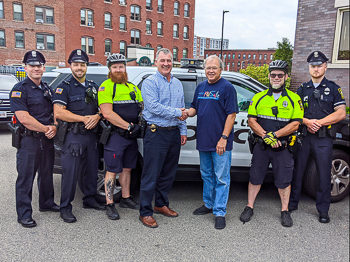
Attorney David W. White visits with Lynn Police Chief Christopher P. Reddy and his officers in mid-June. As part of our Project KidSafe campaign, Breakstone, White & Gluck was proud to donate children’s bicycle helmets to Lynn PD again.
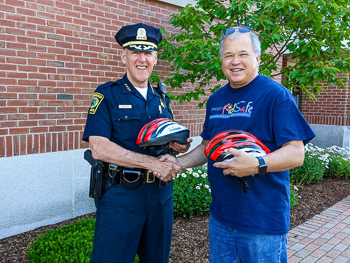
Norwood Police Chief William G. Brooks with Attorney David W. White. Breakstone, White & Gluck donated bicycle helmets to Norwood Police to give away to local children who need one.
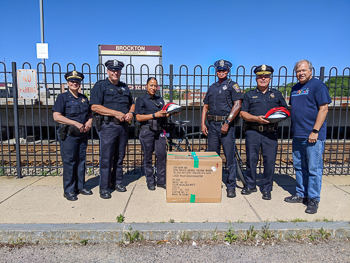
Brockton Police Chief Emanuel C. Gomes and his officers receive a bicycle helmet donation from Breakstone, White & Gluck and our Project KidSafe campaign.
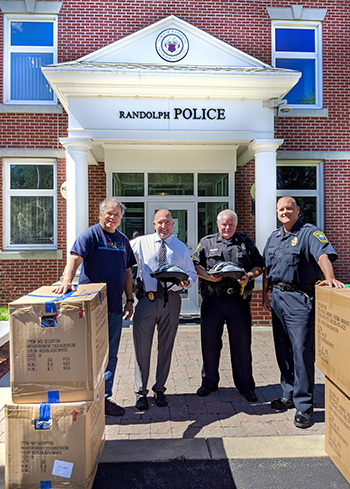
From left: Attorney David W. White delivered bicycle helmets to Randolph Police Chief Anthony Marag for the department’s bike safety event on June 26, 2021.
Read about our donation to Randolph Police.
About Breakstone, White & Gluck
Breakstone, White & Gluck is a top-rated Boston personal injury law firm. Our attorneys are committed to encouraging children to wear helmets when riding a bike to protect against head injuries. This is the law in Massachusetts. All cyclists who are 16 and younger must wear helmets when riding, but we hope our donations also encourage parents and older cyclists to wear helmets and protect themselves.
Through our Project KidSafe campaign, Breakstone, White & Gluck has proudly donated more than 33,000 bicycle helmets to children across Massachusetts.
The Importance of Traffic Cameras in Establishing the Truth: A Video Speaks a Thousand Words
Attorney Ronald E. Gluck recently wrote an article touching on the importance of traffic cameras in his investigation for his client, a cyclist who was seriously injured by a truck. We invite you to read the article, “The Importance of Traffic Cameras in Establishing the Truth: A Video Speaks a Thousand Words,” which is published on the Charles River Wheelers’ website.
You can read more of Ron’s articles by signing up for WheelPeople – The Charles River Wheelers’ newsletter – or by visiting Breakstone, White & Gluck’s website.
Essential Safety Tips for Massachusetts Homeowners with Backyard Swimming Pools
 Over the past year, many of us have missed out on seeing friends and loved ones. If you are planning a summer gathering to make up for lost time, we urge you to consider water safety, especially if you own a backyard swimming pool.
Over the past year, many of us have missed out on seeing friends and loved ones. If you are planning a summer gathering to make up for lost time, we urge you to consider water safety, especially if you own a backyard swimming pool.
With Massachusetts schools about to start summer break, there is a high level of distraction in many homes. Households may have family members working remotely and summer may add to the unpredictable schedules we established during the COVID-19 emergency. But you must be vigilant if you own a pool because the risk for injury is very real. One can drown quickly, in a matter of seconds, and those injured are often young children.
According to the Consumer Product Safety Commission (CPSC), an average of 397 children were killed in swimming pool or spa submersions each year from 2016 to 2018. These children were all under 15 years old. During the same period, there was also an annual average of 6,200 children under 15 treated at hospitals for non-fatal injuries associated with pool or spa submersions.
Already in Massachusetts this year, we have seen several lives lost or nearly lost to drownings in swimming pools, ponds and lakes. In this blog, we focus on how homeowners can reduce the risk for injury and drowning in backyard swimming pools, and their legal responsibilities.
Massachusetts Property Owners Have a Duty to Use Reasonable Care
In Massachusetts, homeowners have a responsibility to use reasonable care to keep their property in reasonably safe condition. When it comes to swimming pools, a property owner’s duty starts with following Massachusetts building regulations to secure pools. They must also maintain safe areas around pools.
It is paramount that Massachusetts homeowners also exercise caution with alcohol. Homeowners can reduce the risk for many drownings and injuries by simply limiting their own alcohol consumption and that of all their guests of legal drinking age. Minors should never be allowed to consume alcohol or a homeowner can face criminal charges and a civil lawsuit if someone is injured.
Secure Your Swimming Pool With Strong Fencing
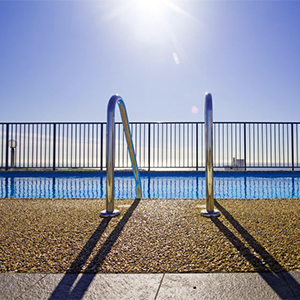
In Massachusetts, the state building code requires property owners to secure swimming pools behind 4-foot high fencing. There are different specifications for above-ground and underground pools, along with pools that use one side of the home as part of the fence.
Pools must be secured with locking devices that face outward away from the pool. The locks must be self-closing and self-latching.
Keep Pool Areas Free From Hazards
Be aware of other potential hazards beyond your actual pool. Your pool area may have outdoor furniture, rafts and floats, a diving board or a slide. One way to prevent a pool-related injury is to limit pool accessories. Secure the products you buy out of sight when you are not using your pool.
We caution you about purchasing diving boards and slides. Accidents involving these products can be serious, resulting in a head injury or a spinal cord injury, which can lead to long-term disability or death. Many homeowners have decided these are just not worth the potential safety risk.
Recognize that these products can be poorly designed or incorrectly installed. A product may not be the right fit for your pool design or reliably support your guests, even if it meets CPSC safety standards. However, if you choose to make a purchase, you should always hire an experienced pool professional to assist you with installation and your homeowner’s insurance agent to make sure your policy provides coverage.
Protect Young Children
 In Massachusetts, property owners are responsible for securing pools from young children. Property owners can be held liable for drowning or other injuries suffered by young children, whether they are invited guests or are trespassing. The law recognizes that young children may not understand when they approach a potential hazard. As a property owner, think about how your pool looks from the street, from your yard and from inside your home. Bright-colored rafts and large crowds can quickly capture a child’s attention. Then think about how you have secured your pool.
In Massachusetts, property owners are responsible for securing pools from young children. Property owners can be held liable for drowning or other injuries suffered by young children, whether they are invited guests or are trespassing. The law recognizes that young children may not understand when they approach a potential hazard. As a property owner, think about how your pool looks from the street, from your yard and from inside your home. Bright-colored rafts and large crowds can quickly capture a child’s attention. Then think about how you have secured your pool.
Keep Gatherings Small
When you invite guests over, keep gatherings small so you can observe the pool area and enjoy the company.
Closely Monitor Guests Near Your Swimming Pool
Never invite anyone over to your home to use your swimming pool when you are not there or are engaged in another activity, such as work. Ask if adult guests know how to swim and if children have attended swimming lessons.
If you have young children, commit to watch them and any friends they invite over closely, even if they are not using your pool. Limit the size of gatherings so you can give the children your full attention.
Make the same commitment to safety if you are the parent of a teenager, even if you normally give them more freedom. Set summer rules and make sure your teen understands: they can only have friends over when you are home and gatherings should be kept small. They should always ask before using the swimming pool and you will not permit alcohol.
Whenever you have any guests over, check that your pool is fully secured before they arrive. Not just from outside, but also from guests and children in your home and backyard. Once your guests arrive, it can help to utilize a pool camera, sounding alarm or other technology, even if no one is using the pool. You can also take the low-tech approach of sitting outside where you can see both the pool and the gate. This step shows your guests and children you are truly committed to safety and want them to have fun, but also act responsibly so everyone gets home safely.
Restrict Alcohol Consumption by Your Guests; Never Allow Teens to Drink At Your Home
 Carefully consider whether you want to allow your guests to consume alcohol in your home, especially when they come over to swim or are driving. This decision comes with a lot of responsibility. The easiest approach is to not allow alcohol consumption. If you do allow your guests to drink, practice moderation and good judgment. Never let them drive home under the influence.
Carefully consider whether you want to allow your guests to consume alcohol in your home, especially when they come over to swim or are driving. This decision comes with a lot of responsibility. The easiest approach is to not allow alcohol consumption. If you do allow your guests to drink, practice moderation and good judgment. Never let them drive home under the influence.
As for swimming, remember that alcohol and pools are a dangerous combination. According to the Centers for Disease Control and Prevention, alcohol use is involved in up to 70 percent of deaths associated with all water recreation. Drinking beer or liquor in the warm weather can contribute to dehydration, which can raise the risk for drowning and submersion injuries.
Massachusetts recognizes social host liability. There can be serious consequences for bad decisions. Homeowners can face criminal charges, including jail time, if they allow minors under 21 to consume alcohol at their home or any property they control, under M.G.L. c. 138 § 34 . Parents can also be criminally charged and convicted if police can prove they left their home and were aware minors were consuming alcohol there in their absence. Minors can also be criminally charged.
In addition to criminal charges, a homeowner can also face a civil lawsuit from those injured as a result of a minor’s alcohol consumption at their home.
Limit Cell Phone Use and Distractions
One can easily become distracted by an email, text or social media and this can be dangerous if you have a pool. If you are checking your cell phone, you could miss the moment someone needs your help. Every second counts when it comes to saving someone from drowning. The best approach is to limit cell phone use and enjoy your guests. Keep both your home and cell phone nearby, but for emergencies only.
Free Legal Consultation – Boston Personal Injury Attorneys
At Breakstone, White & Gluck, our attorneys provide aggressive representation and are committed to achieving the best result for clients. Founded in 1992, our personal injury law firm specializes in representing those injured by the negligence or wrongdoing of others and our attorneys have been consistently recognized by Super Lawyers and Best Lawyers in America. We have won numerous record-setting verdicts and settlements in negligence, product liability and medical malpractice cases in Massachusetts. We offer safety tips as part of our Project KidSafe campaign, through which we work to prevent injuries to children and families.
If you or a family member has been injured, learn your legal rights. We represent clients across Massachusetts, including in Boston, Cambridge, Somerville, Quincy, the North and South Shores, Cape Cod, Worcester and Central Massachusetts. For a free legal consultation, contact one of our Boston personal injury lawyers at 800-379-1244 or 617-723-7676 or use our contact form.


